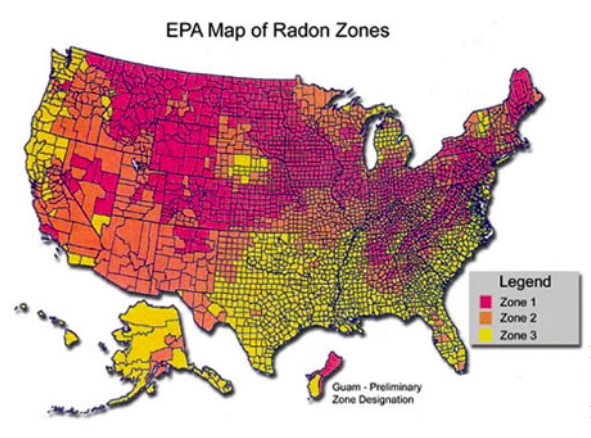![]() Printable PDF Radon in South Florida
Printable PDF Radon in South Florida
Radon (chemical symbol Rn) is a naturally occurring radioactive gas found in soils, rock, and water throughout the U.S.
What is Radon?
Radon (chemical symbol Rn) is a naturally occurring radioactive gas found in soils, rock, and water throughout the U.S. It has numerous different isotopes, but radon-220, and -222 are the most common. Radon is the product of decaying Uranium. Since uranium is essentially everywhere in the earth's crust, Radon is present in almost all rock, soil, and water.
Radon causes lung cancer, and is a threat to health because it tends to collect in homes, sometimes to very high concentrations. Radon is a heavy gas, which accounts for its tendency to collect in basements. It has no color, odor, or taste. As a result, radon is the largest source of exposure to naturally occurring radiation.
How does Radon get in my home and me?
Radon is generated in rock and soil, and it creeps up to the outside air. Although outdoor concentrations of radon are typically low, about 0.4 Pico curies per liter (pCi/l) of air, it can seep into buildings through foundation cracks or openings and build up to much higher concentrations indoors.
The average indoor radon concentration is about 1.3 pCi/l of air. It is not uncommon, though, for indoor radon levels to be found in the range of 5 - 50 pCi/l, and they have been found as high as 2,000 pCi/l. It is estimate that about 1 in 15 homes nation- wide have levels at or above the level of 4 pCi/l, the level at which EPA recommends taking action to reduce concentrations.
The concentration of radon measured in a house depends on many factors, including the design of the house, local geology and soil conditions, and the weather. When radon decay occurs in air, the de- cay products can cling to aerosols and dust, which makes them available for inhalation into the lungs.
Radon easily dissolves in water. In areas of the country that have high radium content in soils and rocks, local ground water may contain high concentrations of radon. While radon easily dissolves into water, it also easily escapes from water when exposed to the atmosphere, especially if it is stirred or agitated. Consequently, radon concentrations are very low in rivers and lakes, but could still be high in water pumped from the ground. However, radon from domestic water generally contributes only a small proportion (less than 1%) of the total radon in indoor air.
What is the Radon concentration in this area?
When compared nationally, with the exception of a sliver of land along the coast of northern Martin County, Radon concentrations fall within the “low category” and are generally not considered a concern in need of testing or mitigating construction techniques.
How do I test for Radon?
You cannot see, feel, smell, or taste radon and testing for it in your home is relatively easy. Typically an air canister is placed inside the structure for 24-48 hours and tested in a laboratory. There are many home test kits. The EPA Citizen's Guide to Radon describes commonly available tests for measuring radon concentrations in the home. EPA recommends reducing levels of radon in homes where radon concentrations exceed the EPA radon action level of 4 picocuries per liter.
It is a violation of Chapter 404, Florida Statutes and Chapter 64E-5, Florida Administrative Code to provide radon services without being currently radon certified by the Florida Department of Health. Specialists and technicians must provide radon services only through affiliation with a Florida certified radon business. Businesses and individuals will be fined for non-compliance.

- Zone 1 counties have a predicted average indoor rason screening level greater tgan 4 pCi/L )pico curies per liter) Highest Potential
- Zone 2 counties havea predicted average indoor radon screening level between 2 and 4 pCi/L Moderate Potential
- Zone 3 counties have a predicted average indoor radon screening level less than 2pCi/L LowPotential
The EPA’s web site recommends that all homes should test for radon, regardless of geographic location or zone designation Elevated levels can be found in Zone 2 and Zone 3 counties. All users of the map should carefully review the map documentation for information on within-county variations in radon potential and supplement the map with locally available information before making any decisions.
For more information check:
EPA’s “A Citizens Guide to Radon”
The EPA’s “About Radon”
Radon Exposure in Florida




















